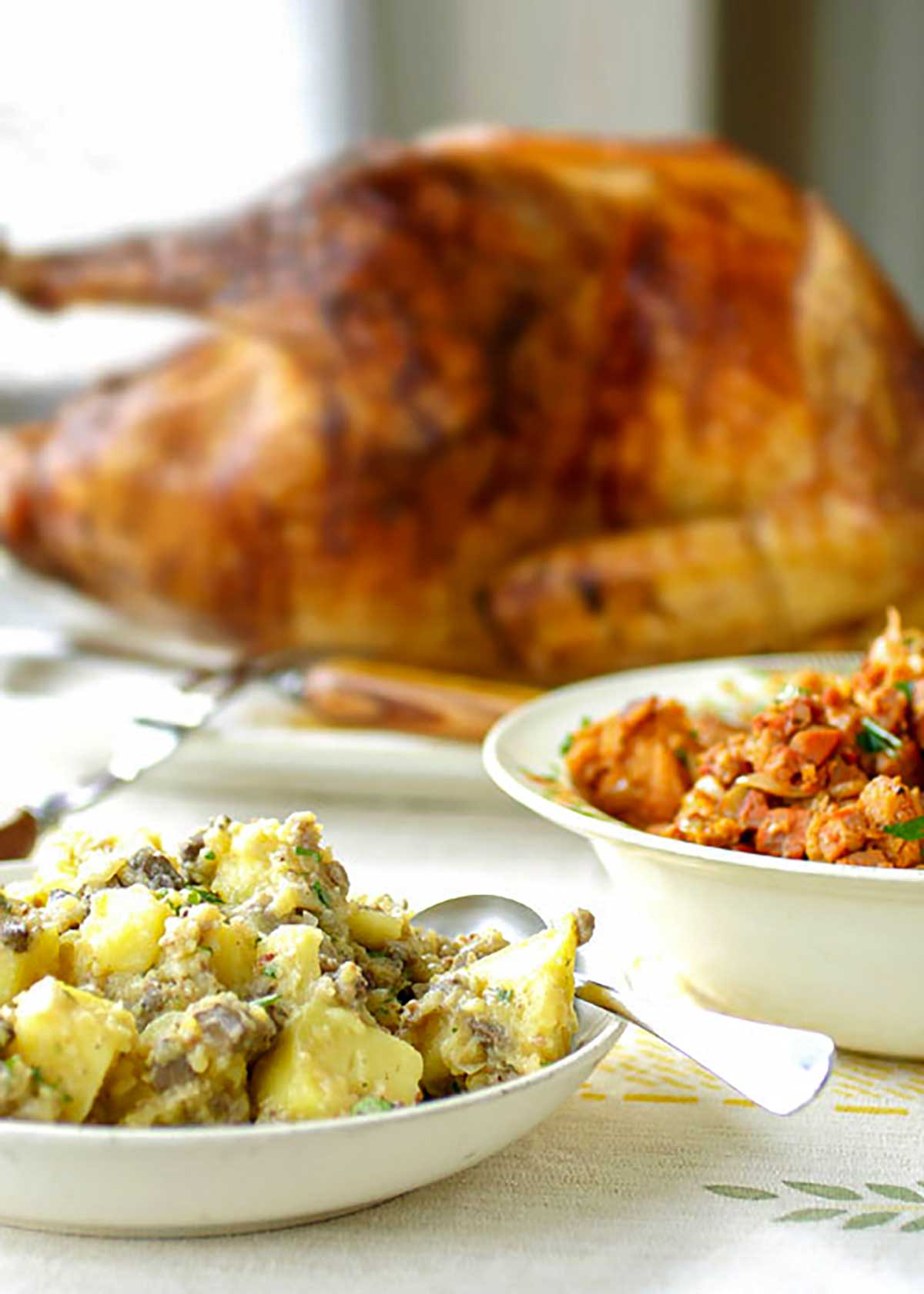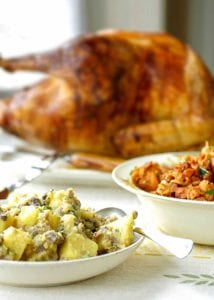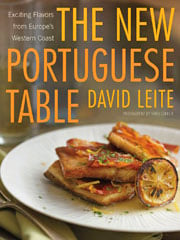
This is the same paprika-sprinkled Portuguese turkey that I grew up with. My grandmother Costa always rubbed her poultry with salt and let it sit in the fridge for several hours prior to roasting, believing that it drew out impurities. Her ritual is similar to the koshering process, in which poultry is coated with salt and later rinsed several times. The benefit—voodoo aside—is a bird that’s juicy and richly flavorful. That’s why I insist you buy a kosher turkey. And I’m offering you a couple different Portuguese stuffings. Because one is never enough.–David Leite
☞ READ THE ARTICLE: A TALE OF TWO PORTUGUESE STUFFINGS ☜

Portuguese Turkey with Two Stuffings
Equipment
- Kitchen string
Ingredients
For the turkey
- One (12- to 14-pound) kosher turkey, liver reserved for the dressing
- 1 small orange, cut into wedges
- 1 small lemon, cut into wedges
- Kosher salt and freshly ground black pepper
- 4 Turkish bay leaves
- 6 tablespoons unsalted butter, melted
- 2 teaspoons sweet paprika
For Dina’s potato stuffing
- 1 1/2 pounds Yukon Gold potatoes, peeled and cut into 1‑inch cubes
- Kosher salt
- 2 tablespoons unsalted butter, plus more if needed
- 3/4 pound ground sweet Italian pork sausage
- 1 large yellow onion, chopped
- 2 garlic cloves, minced
- Reserved turkey liver, chopped
- 2 large egg yolks, beaten
- 1/2 cup whole milk, plus more if needed
- Healthy pinch ground nutmeg
- 2 tablespoons chopped flat-leaf parsley leaves
- Freshly ground black pepper
For Avó Costa’s bread stuffing
- 1/4 pound thick-sliced slab bacon, cut crosswise into 1/4-inch pieces
- 1 pound chouriço, linguica, or dry-cured smoked Spanish chorizo, roughly chopped
- Olive oil, if needed
- 2 medium yellow onions, chopped
- 4 garlic cloves, minced
- 1/4 teaspoon crushed red pepper flakes
- 2/3 cup dry white wine
- 3 tablespoons Amped-Up Red Pepper Paste
- 2 tablespoons double-concentrate tomato paste, or three tablespoons regular store-bought or homemade tomato paste
- 12 cups 3/4-inch (18-mm) cubes of day-old rustic bread
- About 2 cups homemade beef stock plus 1 cup water or 3 cups store-bought low-sodium broth
- Kosher salt and freshly ground black pepper
- 1/4 cup chopped flat-leaf parsley leaves
For the gravy (optional, seeing as it’s not the Portuguese way, but so worthwhile)
- Up to 3 cups homemade chicken stock or low-sodium chicken broth
- 1/4 cup unsalted butter, at room temperature
- 1/4 cup all-purpose flour
- Kosher salt and freshly ground black pepper
Instructions
Roast the turkey
- Position a rack in the bottom of the oven and crank up the heat to 425°F (218°C).
- Pat the turkey dry with paper towels. Rub the inside of the cavity with the cut side of 1 wedge of orange and 1 wedge of lemon and then toss them in the cavity. Generously season the cavity with salt and pepper and then stuff it with the remaining wedges and the bay leaves. Tuck the wing tips beneath the bird, as if it were folding its arms behind its head, and tie the legs together with kitchen string.
- In a small bowl, mix together the melted butter, paprika, 1 1/2 teaspoons salt, and 1 teaspoon pepper. Brush about half of the butter mixture over the turkey. Place the bird, breast side down, on a V-rack set in a roasting pan.
- Slip the turkey into the oven, pour 2 cups of water into the pan, and roast for 30 minutes. Reduce the heat to 350°F (176°C), flip the bird breast side up, and brush with some of the remaining butter mixture.
- Continue roasting the turkey, brushing it every 30 minutes with the butter mixture, until an instant-read thermometer inserted into the thickest part of the thigh registers 165°F (74°C), 1 1/2 to 2 hours more. Tent the bird with foil if it’s browning too quickly.
- Transfer the turkey to a serving platter and let stand, tented, for 20 minutes. Although it’s not the custom in Portugal, you can make gravy.
Make Dina’s potato stuffing
- While the turkey roasts, toss the potatoes in a large pot of cold water. Add 1 tablespoon salt, cover, and bring to a boil over high heat. Cook until tender, 10 to 15 minutes. Drain the potatoes, return half of them to the pot, and mash well with a handheld masher or a fork. Set the rest of the potatoes aside and cover to keep warm.
- In a medium skillet over medium-high heat, warm the butter until it melts and the foaming subsides. Crumble in the ground sausage and cook, breaking up the clumps, until well browned, 10 to 12 minutes.
- Using a slotted spoon, scoop the sausage into the pot with the mashed potatoes and set that aside for the moment. Reduce the heat under the skillet to medium and, if the skillet seems dry, add a little more butter. Add the onion and cook, stirring occasionally, until golden, about 12 minutes. Stir in the garlic and cook, stirring, for 1 minute more. Add the chopped reserved liver and cook, stirring, until browned, about 3 minutes more. Scoop the mixture into the pot with the mashed potatoes.
- Whisk the yolks and milk into the potato mixture until smooth; if the dressing seems too thick, whisk in more milk. Place the pot over medium heat and stir until the yolks are cooked, about 3 minutes. Fold in the reserved potatoes, sprinkle in the nutmeg and parsley, and season well with salt and pepper to taste. Keep warm.
Make Avó Costa’s bread stuffing
- While the turkey roasts, warm a Dutch oven over medium-low heat. Add the bacon and cook, stirring often, until the bacon is crisp and the fat has rendered, 12 to 15 minutes.
- Using a slotted spoon, transfer the bacon to paper towels. Pour off all but a thin film of fat from the pot into a cup. Bump up the heat to medium-high, add the chourico, and cook, stirring often, until lightly browned, about 7 minutes. Using a slotted spoon, transfer the sausage to a bowl. Pour off all but 2 tablespoons of fat, adding it to the bacon fat. If the Dutch oven seems dry, add 2 tablespoons of oil.
- Lower the heat to medium, add the onions, and cook until softened, 7 to 10 minutes. Add the garlic and pepper flakes and cook for 1 minute more. Splash in the wine, add the red pepper paste and tomato paste, and stir to scrape up any stuck-on bits. Then let everything burble for a few minutes to cook the mixture.
- Turn the heat to low, add the bread and the reserved bacon and chourico fats, and pour in just enough of the stock-water combination, beating well with a spoon, to make the mixture moist. If you use all the liquid and the pot is still dry, add water as necessary. Fold in the bacon and chourico and continue beating to lighten the mixture. Take a taste and season with salt and pepper if needed. Scoop the dressing into a bowl and sprinkle with the parsley.
Make the gravy (not traditional but knock yourself out if you’d like!)
- Spoon off and discard the fat from the surface of the juices in the roasting pan. Place the pan over 2 burners and add enough homemade chicken stock or store-bought low-sodium broth to the juices in the pan to equal 3 cups. Bring the liquid to a boil over medium-high heat, scraping the bottom to loosen any browned bits.
- In a small bowl, blend together the butter and flour until a smooth paste forms. Whisking constantly, slowly add the paste to the liquid in the roasting pan and whisk until the gravy thickens and no floury taste remains, 5 to 10 minutes. Strain and season with salt and pepper to taste.
Serve the turkey and dressing(s)
- When you're ready to sit down to dinner, plate the turkey, scoop the dressings into decorative bowls, and take everything to the table pronto.
Video

Nutrition
Nutrition information is automatically calculated, so should only be used as an approximation.










Hi, David. My Ávo and mom always made a turkey for Thanksgiving, although they never ate turkey growing up in Portugal because it was expensive. My Ávo would make an all-meat stuffing and STUFF it in the bird, then cook it. She would save up scraps of meat and freeze them, then pull them out for the big day and put them through a meat grinder. It was like a croquette but made into stuffing. I also remember alot of lemon–both in the stuffing and in the gravy. It was the BEST stuffing. What I wouldn’t give to have a taste of that meat stuffing again!
Susanne, that sounds maravilhoso. Tell me: Was there any potato in the stuffing?
Johnny Boy’s stuffing comes very, very close to my Avo’s and I am thrilled to have written it down! The only thing i don’t get is frying the stuffing? My Avo used to put it in the turkey and any left over was put into a baking dish. I would like to know how this stuffing could be fried and then what, put it into the turkey afterward? I don’t remember this process but as I said, I was really little.
Thanks so much, it is a pleasure to finally be connected back with my people!
Hi David, It’s funny when a stranger is writing about your own family… I think those stories exists anywhere on the globe but it’s always nice to read them.
The part about the Kosher turkey caught my eye; there are many Portuguese Christians families who have in fact Jewish roots, they are “Converso.” It’s known that most of them consider themselves as Christians today, but are still practicing for hundreds of years, the same Jewish customs of their ancestors in food, cooking etc.
Back to the bird…. You wrote: “The benefit…is a bird that’s juicy and richly flavorful.” Since I’m using the Kashrut rules, it’s known that meats are more tender and moist if you don’t put salt on them, because the salting dries them. We are allowed to skip the salting if we put meats on an open fire or grill. This way you get it juicy and tender, better than after the salting procedure.
Abigail, thanks for writing. I’m quite aware of the Conversos. There’s a theory floating around that Portuguese folks with an object (noun) last name are actually Jews who converted to avoid persecution. For example, my last name means milk. Most of the Portuguese I grew up with–Dias (day), Oliveira (olive tree), Carvalho (horse), Flores (flowers), etc.–are possibly of Jewish heritage.
Regarding my grandmother’s (and others’) pre-salting of meats, there seems to be a huge schism in the food/chef world on the topic. Some are for, others are vehemently against. Harold McGee, the dean of food science, is in favor of pre-salting because he says although there’s some superficial loss of moisture, the salting traps water within the cells. The net result is a tastier and moister bird. I’ll look for exactly what he says, if you’d like.